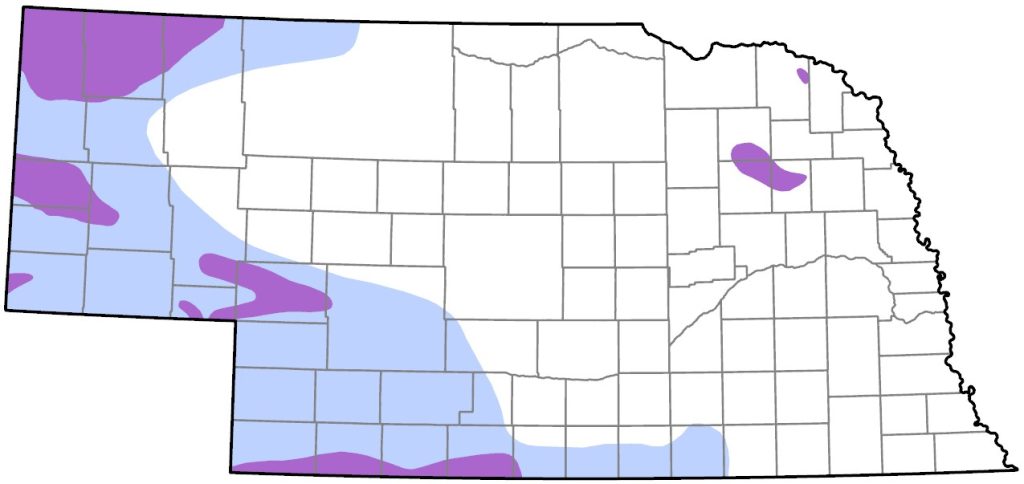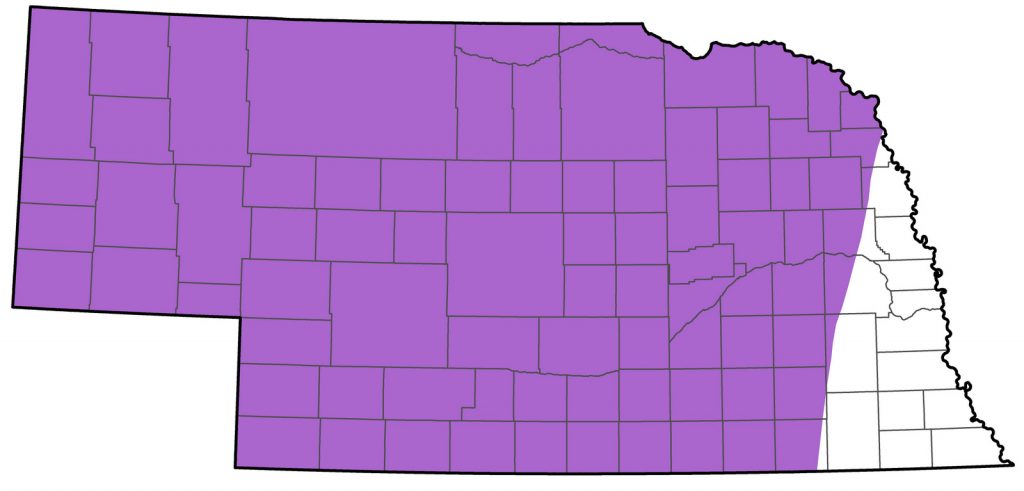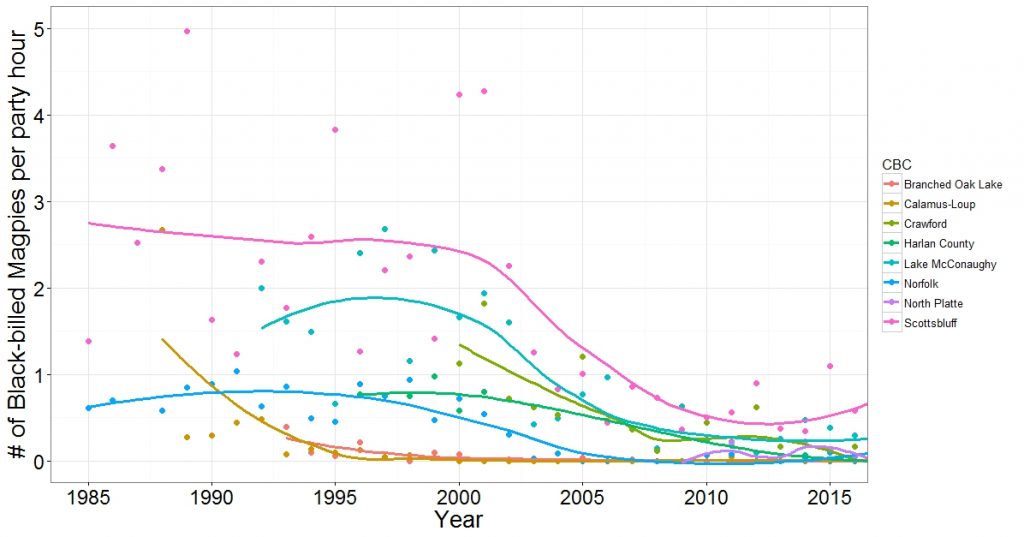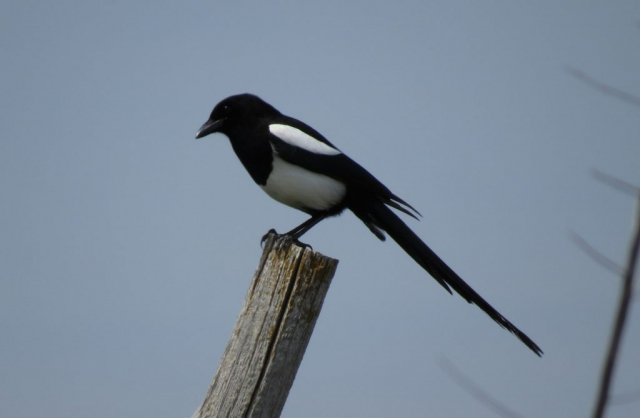Pica hudsonia
Status: Uncommon regular resident west, locally uncommon southwest, rare elsewhere. Rare casual winter visitor west and south away from breeding locations.
Current range
Former Range (prior to 2001, Mollhoff 2001)

Documentation: Specimen: UNSM ZM10305, 14 Jul 1910 Sioux Co.
Taxonomy: North American birds, formerly known as Pica pica hudsonia, were recently afforded specific status, separate from those of Europe (Banks et al 2000).
No subspecies are recognized (AviList 2025).
Changes Since 2000: The range of Black-billed Magpie in Nebraska has diminished westward to a significant extent, and distribution has become increasingly fragmented, with many breeding locations isolated from others and in danger of extirpation. Overall numbers have declined significantly in the last decades, especially from 2003-2013 according to BBS and CBC data (Appendix below). The decline in numbers and reduction in range has occurred since the arrival of West Nile Virus and that disease is believed to be the source of the declines (Brenner and Jorgensen 2020, Comments below). The current (2019) range map shown above was revised from the original that was created at the end of 2017, a topic discussed on this blog post.
Resident: Jorgensen (2016) reviewed the status of this species in Nebraska. Prior to 1900 Black-billed Magpie bred virtually statewide, including Cuming, Cass, and Gage Cos (Bruner et al 1904). After 1900 the range contracted and by mid-20th Century breeding was confined to the west and northwest, where it was still a common breeder (Rapp et al 1958). Since the 1950s, numbers have fluctuated markedly, especially beginning around 2004, when numbers declined significantly for a few years. BBS Trend Analysis 1966-2019 showed an annual decline of -7.03% (95% C.I.; -9.21, -4.8 (Sauer et al 2020). Mollhoff (2016) found a “precipitous decline” in the percentage of BBA blocks reporting this species from 34% during 1984-89 to 8% in 2006-2011.
Until the mid-2010s, the Pine Ridge and North Platte River Valley were strongholds; a flock of 32 was at Fort Robinson SRA, Dawes Co 2 Oct 2015 and there were “lots at various places” in Sioux Co 22-23 Jun 2015. The Scottsbluff CBC 18 Dec 2014 counted 24, and there were 11 additional reports 2014-2016 from Scotts Bluff Co of 1-6 birds; 13 in two family groups were at Stateline Island 4 Jun 2019. A colony of six nests with eggs was seven miles southwest of Redington, Morrill Co on the Bighorn Escarpment 11 May 2002 (Mollhoff 2004). However, since 2018, an active observer, Steven Mlodinow, detected the following trend in Scotts Bluff and Keith Cos: “numbers increased in Scotts Bluff [Co] after I first started birding there in 2018, with peak numbers/frequency in 2021 (on 23 lists) and 2022 (31 lists) but then dropped dramatically in 2023 (14 lists) and 2024 (only once so far).” Similarly, “Keith [Co] seems to have had a similar trajectory, but my visits there are more sporadic. I had BBMA in Keith several times each year from 2020-2022 (including 16 birds along NPPD channel on 2 October 2022), but not one last year and only one (despite a fair number of visits) this year.” A rough tally of eBird numbers for the years 2015-2023 in the North Platte River Valley averaged 94 for 2015-2019 (high 129 in 2019), peaked at 300, 285, and 318 for 2020-2022, and dropped to 207 for 2023. In spring 2024, 34 magpies were reported in Scotts Bluff Co, two in Morrill Co, and only six in Keith Co.
CBC data suggest severe overall declines at certain locations. The Harlan County Reservoir CBC, Harlan Co 21 Dec 2014 found none, compared with three the previous year and an average of 24 per year 1996-2001. The North Platte CBC had five in 2014-2015, the best count for 2008-2015, but insignificant compared to the count’s record of 194 in 1938, and the 2019-2020 CBC was the third consecutive with none found. On the Norfolk CBC in Madison Co, as many as 222 were counted 1985-1989, and only five in 2019-2020. During winter 2013-2014, only 32 in all were reported on CBCs, all in the west: 16 at Lake McConaughy 29 Dec, 10 at Scottsbluff 15 Dec, five at Crawford 21 Dec, and one at Harrison 22 Dec.
In the Niobrara River Valley, reports are few but encouraging; in Boyd Co one was at Parshall Bridge 17 Oct 2022 and another near Butte 4 May 2023, and in Keya Paha Co one was near Mills 20 Jan 2023, three were there 12 Apr 2023, and one on 25 Oct 2024.
One was at Calamus Reservoir, in Garfield Co 3 Mar 2024, and singles were along Croughwell Road, Loup Co 9 Jun 2024 and near Taylor, Loup Co 17 Aug 2024. These locations are within about 20 miles of each other.
A family group of eight was in Snell Canyon, Lincoln Co 8 Jul 2014 and seen again 21 Nov, although none were found in the cedar canyons in Lincoln Co on 453 count points in 2013; however, four were in Snell Canyon 14 Dec 2022. In 2011, three groups of 9-15 were in Custer Co 20 Apr, one was at Pressey WMA, Custer Co 30 Dec 2016, and one was at Broken Bow, Custer Co 6-19 Sep 2021. One at Calamus Reservoir, Loup Co 24 Jun 2020 was only the 6th record there since 1988.
In the Platte River Valley, there was a small population of up to five in extreme northern Phelps Co 2014-2018 (Andrew Furman, personal communication), it was noted in 2015 that “it seems like more get reported from [the area around the Gibbon I-80 exit], Buffalo Co than any other spot in the eastern two-thirds of the state”, and five were seen in Adams Co 27 Sep 2019 about 15 miles south of Gibbon. One was at Belgrade WTP, Nance Co 23 Nov 2021. In Dawson Co, one was near Cozad 12 May 2022, two at Plum Creek Park Lexington 25 Aug 2022, and one near Darr 25 May 2024.
Since about 2000, numbers in the northeast have been sporadic and scattered at best, and numbers have declined significantly. Most reports have been from two general areas: northern Cedar Co and Madison Co, and adjacent counties to these.
In northern Cedar Co, four were reported 7-18 Mar 2014 at a “usual spot” in the area of 897 Road and 563 Ave, in 2022 two were on private property near 896th and 557th, some 4-5 miles farther east, and up to nine were in the area of Antelope Creek and 896 Road 17-21 Dec 2020. In 2023 along 898 Road in Cedar Co one was seen 18 Dec, and the homeowner stated magpies had been present and nesting in his yard there “most years”.
Other Cedar Co reports are from a few miles southwest of Obert, where a nest was found in 2017, three birds were present 31 Jul 2019, nine on 17 Dec 2020, singles 4 Mar and 15 Apr 2021 and four on 10 May 2022.
A population in Madison Co is persisting in low but possibly increasing numbers mostly within 547-556 Avenues and Roads 835-845. Since 2014 and through 2024 there have been several reports in this area of as many as 5-8 birds, best count eight on 2 Sep 2017. Two were along 836 Road 2 Mar 2024, singles were there 5 and 14 Oct 2024, four on 23 Feb 2025, and 1-2 from 12 Mar-22 May 2025.
In adjacent Pierce Co, a nest was found in 2018, a single bird was seen near Willow Creek SRA 20 Jan 2019 (David Heidt, personal communication), and in 2022 singles were seven miles apart along 564th on 2 Mar and on Highway 13 on 11 Apr.
In Knox Co, there are only four reports since 2005: Jul 2005, 9 Sep 2011, 26 Feb 2017, and 6 Apr 2025, and in Dixon Co one was reported in 2010 and three were found 7 Apr 2018. There are sporadic reports since 2010 from counties adjacent to Madison and Pierce, including Antelope, Thurston, Cuming, and Stanton; of the five reports, most recent is from Thurston Co 19 May 2014. Unexpected were singles near Lyons, Burt Co 25 Dec 2022 and near Brunswick, Antelpe Co 17 Jun 2025.
There are no current (2023) breeding locations in eastern Nebraska except for Madison and Cedar Cos and possibly Pierce Co. The most recent records from Dodge Co south were of a nest with five eggs 28 May 2002 in Dodge Co; a nest was found there in 2004 and another in 2005 that was later abandoned. Nesting occurred in Seward Co in 2007. Breeding has occurred in Lancaster Co, but there have been no breeding reports since 1987. Gubanyi (2020) noted the decline in records on the Seward-Branched Oak Lake CBC, Lancaster Co from 25 in the first CBC there in 1993 to only 0-2 in the years 2001-2007 and none since; Gubanyi does not believe it is likely this species will occur on the CBC again.
The species may still be persisting in northwestern Jefferson Co, where one was present 24 Jun 2017 (Matt Hansen, personal communication).
Possible signs of incipient recovery in the southwest were scattered sightings in 2022 of singles near Holbrook, Furnas Co 4 Jun, on Ash Creek Canyon Road, Custer Co 7 Jun, and in McCook, Red Willow Co 16 Jun. Similarly, in 2023 six were at Hayes Center, Hayes Co 11 Mar and two on 17 Dec, two at Enders, Chase Co 16 Apr, one in Frontier Co 17 Mar and another there 15 Dec 2015, and singles in Franklin Co 24 Sep, Cheyenne Co 30 Oct, and Furnas Co 21 Nov. In 2024 there were 12 reports in the southwest, including Cheyenne, Kimball, Lincoln, and Hayes Cos. Five were near Eddyville, Dawson Co 15 Jul 2024.
Breeding Phenology:
- Tending nest: 8-21 Apr
- Eggs: 5 Apr- 19 Jun (Mollhoff 2022)
Nestlings: 20 May-9 Jun
Fledglings: 17 May-11 Jul
A photographic documentation through the nesting season of a nest in Hall County in 2004 was made by Ron and Anne Kruse (Mollhoff 2013).
- High counts: 107 in Scotts Bluff Co 23 Aug 1996, 65 at Lake Ogallala, Keith Co on 2 Sep 1993, and 50+ near Gibbon, Buffalo Co 31 Aug 2000, all apparently post-breeding flocks.
Winter: This species is not migratory, but occasionally exhibits post-breeding dispersal to areas where it does not breed. Blake and Ducey (1991) noted that “occasional wanderers” appeared in Holt Co in fall; one was in Boyd Co 14 Sep 2020. Near Gilead, Thayer Co, an observer stated in 2014: “I’ve seen several pairs there over the last four years, usually over the winter”, and one was east of Hebron, Thayer Co 21 Sep 2020. At locations on the east edge of the breeding range, post-breeding dispersal occurs in Sep and later. In Lancaster Co 1-2 were reported on Lincoln CBCs up to 1998. Scattered additional easterly reports during the non-breeding season are 13 Mar 2017 Seward Co, 18 Sep 1981 Greenwood, Lancaster Co (Williams 1982), Washington Co 25 Oct 1998 “the first modern record”, 2 Oct 2001 Washington Co, 3 Dec 1998 three miles north of Bennington, Douglas Co, 15 Feb 2013 Saunders Co, and 14 Mar 1987 Douglas-Sarpy Cos. Two were in Dakota Co 25 Oct 2020.
- High counts: 250 in Lincoln Co 14 Jan 1934 (Tout 1947) and 50+ in Scotts Bluff Co 3 Dec 2012.
Comments: The pattern and cause of recent declines has been discussed by various individuals. Mollhoff (in Silcock 2013) believed that in most of the state, the species now occurs only in pockets, possibly comprised of family groups, that are susceptible to local extirpation, a conclusion supported by Jorgensen (2016). The definitive cause of the decline in most areas of the state is less clear and may involve various factors. West Nile Virus is the most likely explanation, and may be the sole cause, since recent declines correspond with its arrival in Nebraska and on the Great Plains (Brenner and Jorgensen 2020). Jorgensen (2016) presented data from the Centers for Disease Control that showed the highest rates of West Nile Virus incidence in humans corresponded to the approximate areas where Black-billed Magpies have experienced the greatest declines. Differential West Nile Virus incidence in humans, which may also affect magpies, was attributed to weather and climate cycles that influence the abundance of Culex mosquitoes, an important disease vector, in the Great Plains (Jorgensen 2016). However, other variables may also be affecting magpie populations. Trost (2020) cited studies suggesting that Black-billed Magpie is adapted to “cold, shrub-steppe environment” and distribution might be limited by climatic factors such as temperature and humidity” … “rather than by food availability”. The increase in corn acreage in eastern Nebraska over the last 30+ years, the increased density of planting, and more robust hybrids may have contributed to increased levels of humidity from transpiration during the growing season. This, along with a warming climate may thus be playing a role in the fragmentation of the distribution of eastern Nebraska magpies.
The pesticide Warbex (Famphur), which was used to control eco-parasites in livestock, is fatal to birds when ingested. It is a known source of Black-billed Magpie mortality and may have resulted in declines when it was in use in the 1970s and 1980s. However, the pesticide was banned in 1989 and its use likely diminished rapidly as existing supplies were exhausted (Jorgensen 2016).
Images
Abbreviations
BBA: Breeding Bird Atlas
BBS: Breeding Bird Survey
CBC: Christmas Bird Count
SRA: State Recreation Area
UNSM: University of Nebraska State Museum
WMA: Wildlife Management Area (State)
WTP: Water Treatment Plant
Appendix

Figure 1. Number of Black-billed Magpies recorded per party hour on selected CBCs during the period 1985-2017. Black-billed Magpie abundance was variable throughout the entire period, but fewer Black-billed Magpies were recorded on all CBCs after 2000 and declined in following years.
Literature Cited
AviList Core Team, 2025. AviList: The Global Avian Checklist, v2025. https://doi.org/10.2173/avilist.v2025.
Banks, R.C., C. Cicero, J.L. Dunn, A.W. Kratter, H. Ouellet, P.C. Rasmussen, J.V. Remsen, Jr., J.A. Rising, and D.F. Stotz. 2000. Forty-Second Supplement to the American Ornithologists’ Union Check-List of North American Birds. Auk 117: 847-858.
Blake, L., and J. E. Ducey. 1991. Birds of the eastern Sandhills in Holt County, Nebraska. NBR 59: 103-132.
Brenner, S.J., and J.G. Jorgensen. 2020. Declines of Black-billed Magpie (Pica hudsonia) and Black-capped Chickadee (Poecile atricapillus) in the north-central United States following the invasion of West Nile virus. Western North American Naturalist 80: 204–214.
Bruner, L., R.H. Wolcott, and M.H. Swenk. 1904. A preliminary review of the birds of Nebraska, with synopses. Klopp and Bartlett, Omaha, Nebraska, USA.
Gill, F., D. Donsker, and P. Rasmussen (Eds). 2022. IOC World Bird List (v 12.2). Doi 10.14344/IOC.ML.12.2. http://www.worldbirdnames.org/.
Gubanyi, J. 2020. History of the Seward-Branched Oak Lake Christmas Bird Count 1993-2020. NBR 87: 162-172.
Jorgensen, J.G. 2016. Status review of the Black-billed Magpie (Pica hudsonia) in Nebraska. Nongame Bird Program of the Nebraska Game and Parks Commission, Lincoln, Nebraska.
Mollhoff, W.J. 2001. The Nebraska Breeding Bird Atlas 1984-1989. Nebraska Ornithologists’ Union Occasional Papers No. 7. Nebraska Game and Parks Commission, Lincoln, Nebraska, USA.
Mollhoff, W.J. 2004. The 2002 Nebraska Nesting Report. NBR 72: 153-158.
Mollhoff, W.J. 2013. Photo documentation by Ron and Anne Kruse of Black-billed Magpie nest in Hall County. NBR 81: 81-86.
Mollhoff, W.J. 2016. The Second Nebraska Breeding Bird Atlas. Bull. Univ. Nebraska State Museum Vol 29. University of Nebraska State Museum, Lincoln, Nebraska, USA.
Mollhoff, W.J. 2022. Nest records of Nebraska birds. Nebraska Ornithologists’ Union Occasional Paper Number 9.
Rapp, W.F. Jr., J.L.C. Rapp, H.E. Baumgarten, and R.A. Moser. 1958. Revised checklist of Nebraska birds. Occasional Papers 5, Nebraska Ornithologists’ Union, Crete, Nebraska, USA.
Sauer, J.R., W.A. Link, and J.E. Hines. 2020. The North American Breeding Bird Survey, Analysis Results 1966 – 2019: U.S. Geological Survey data release. https://doi.org/10.5066/P96A7675.
Silcock, W.R. 2013. Fall Field Report, August-November 2013. NBR 81: 134-160.
Tout, W. 1947. Lincoln County birds. Published by the author, North Platte, Nebraska, USA.
Trost, C.H. 2020. Black-billed Magpie (Pica hudsonia), version 1.0. In Birds of the World (S. M. Billerman, Editor). Cornell Lab of Ornithology, Ithaca, NY, USA. https://doi.org/10.2173/bow.bkbmag1.01.
Williams, F. 1982. Southern Great Plains Region. American Birds 36: 193.
Recommended Citation
Silcock, W.R., and J.G. Jorgensen. 2025. Black-billed Magpie (Pica hudsonia). In Birds of Nebraska — Online. www.BirdsofNebraska.org
Birds of Nebraska – Online
Updated 26 Aug 2025

